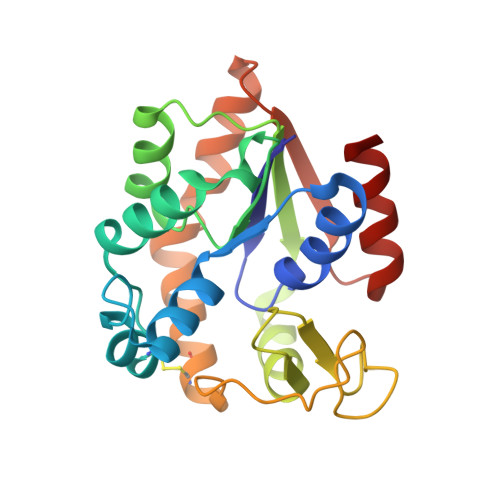Structural basis for ligand binding to an enzyme by a conformational selection pathway.
Kovermann, M., Grundstrom, C., Sauer-Eriksson, A.E., Sauer, U.H., Wolf-Watz, M.(2017) Proc Natl Acad Sci U S A 114: 6298-6303
- PubMed: 28559350
- DOI: https://doi.org/10.1073/pnas.1700919114
- Primary Citation of Related Structures:
5EJE - PubMed Abstract:
Proteins can bind target molecules through either induced fit or conformational selection pathways. In the conformational selection model, a protein samples a scarcely populated high-energy state that resembles a target-bound conformation. In enzymatic catalysis, such high-energy states have been identified as crucial entities for activity and the dynamic interconversion between ground states and high-energy states can constitute the rate-limiting step for catalytic turnover. The transient nature of these states has precluded direct observation of their properties. Here, we present a molecular description of a high-energy enzyme state in a conformational selection pathway by an experimental strategy centered on NMR spectroscopy, protein engineering, and X-ray crystallography. Through the introduction of a disulfide bond, we succeeded in arresting the enzyme adenylate kinase in a closed high-energy conformation that is on-pathway for catalysis. A 1.9-Å X-ray structure of the arrested enzyme in complex with a transition state analog shows that catalytic sidechains are properly aligned for catalysis. We discovered that the structural sampling of the substrate free enzyme corresponds to the complete amplitude that is associated with formation of the closed and catalytically active state. In addition, we found that the trapped high-energy state displayed improved ligand binding affinity, compared with the wild-type enzyme, demonstrating that substrate binding to the high-energy state is not occluded by steric hindrance. Finally, we show that quenching of fast time scale motions observed upon ligand binding to adenylate kinase is dominated by enzyme-substrate interactions and not by intramolecular interactions resulting from the conformational change.
Organizational Affiliation:
Department of Chemistry, Umeå University, SE-901 87 Umeå, Sweden; magnus.wolf-watz@umu.se michael.kovermann@uni-konstanz.de.
















